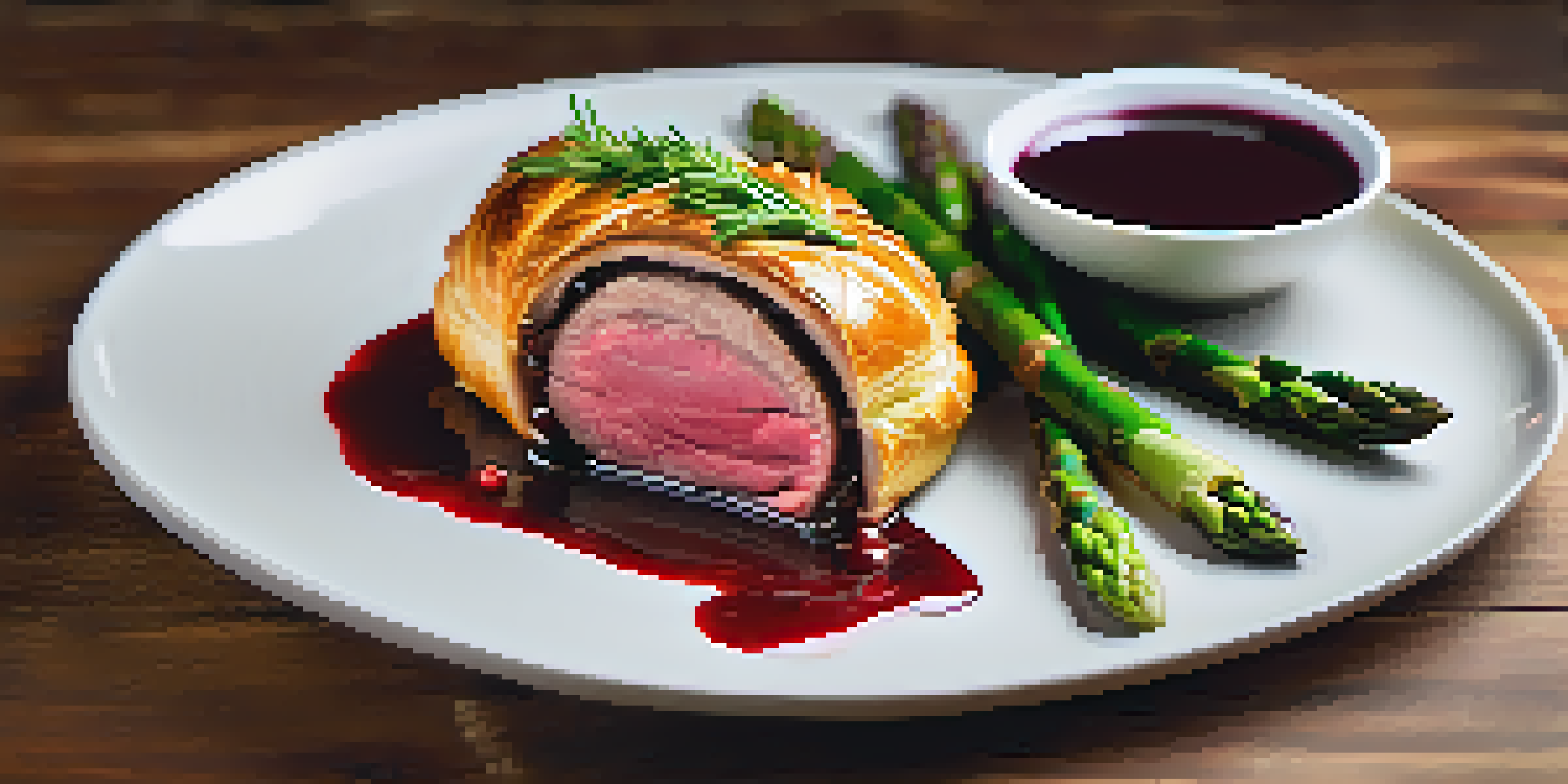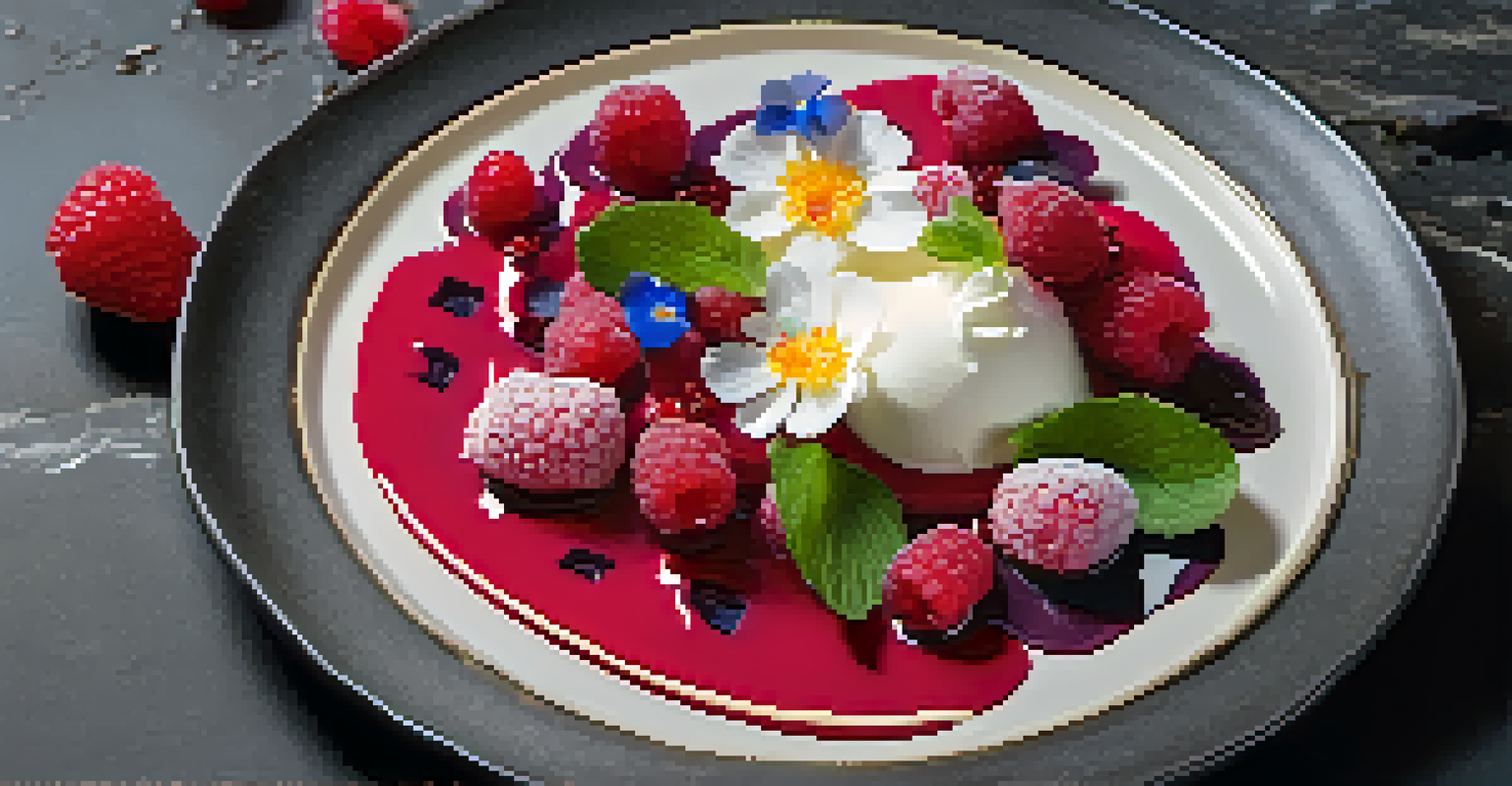Understanding Plating Styles: From Classic to Contemporary

The Essence of Plating: Why It Matters
Plating is more than just a visual appeal; it's the art of presentation that transforms a meal into an experience. A beautifully plated dish can evoke emotions and stimulate the appetite, making the meal more enjoyable. In many ways, plating is the final touch that showcases the chef's creativity and attention to detail.
Food is not just what you eat; it is also how it is presented.
Think of it like wrapping a present. Just as the wrapping can enhance the excitement of the gift inside, plating elevates the dish, inviting diners to savor not only the flavors but also the aesthetics. This connection between visual and gustatory appeal is crucial in today's culinary landscape, where dining is often as much about the experience as it is about the food.
As we explore different plating styles, remember that each approach tells a story about the dish, the chef, and even the culture from which it originates. This narrative aspect of plating adds depth to the dining experience, encouraging diners to engage with their meals on multiple levels.
Classic Plating: Timeless Elegance
Classic plating is characterized by its simplicity and elegance, often focusing on the quality of the ingredients rather than elaborate designs. This style typically features symmetrical arrangements, ensuring that every element on the plate serves a purpose. Dishes like Beef Wellington or Coq au Vin exemplify classic plating, showcasing the food in a straightforward yet appealing manner.

A key aspect of this style is the use of white plates, which allow the vibrant colors of the food to shine. By creating a neutral background, chefs can highlight the textures and hues of the ingredients, drawing the diner’s eye to the dish itself. It’s akin to an artist using a blank canvas to showcase their masterpiece, where the food is the star.
Plating Enhances Culinary Experience
The art of plating transforms a meal into a sensory experience, inviting diners to engage with both the flavors and aesthetics.
Classic plating often evokes feelings of nostalgia and comfort, reminding diners of traditional meals and cherished recipes. This style is perfect for fine dining establishments that aim to create a sophisticated atmosphere while celebrating the beauty of culinary simplicity.
Modern Plating: A Canvas for Creativity
Modern plating breaks away from the constraints of traditional presentation, encouraging chefs to express their creativity. This style often features unexpected shapes, colors, and arrangements, turning the plate into a canvas for culinary art. Dishes might be presented in asymmetrical designs, with sauces drizzled artistically around the main component, inviting curiosity and excitement.
Presentation is everything. It’s a way of expressing your identity through food.
Think of modern plating as a form of storytelling, where each component plays a role in the overall narrative. Ingredients are often deconstructed, allowing diners to experience familiar flavors in new ways. This playful approach not only enhances the visual allure but also engages the diner’s imagination, making the meal a memorable experience.
However, it’s important to maintain a balance between creativity and functionality. While modern plating encourages bold choices, the flavors must still harmonize, ensuring that the dish is as delicious as it is beautiful. This fusion of taste and visual appeal is what makes modern plating so captivating.
The Rise of Minimalism in Plating
Minimalism in plating is a trend that emphasizes simplicity and the beauty of fewer elements. This style often features a single focal point, surrounded by empty space, allowing the dish to breathe and the flavors to stand out. By stripping away the excess, chefs can highlight the quality of their ingredients and the skill involved in preparing them.
Consider the famous Japanese dish sashimi, which is often served with just a few slices of fish and perhaps a garnish of wasabi. The focus is on the freshness and quality of the fish, showcasing its natural beauty. Minimalist plating encourages diners to appreciate the essence of each ingredient, fostering a deeper connection to the meal.
Sustainability Influences Future Plating
Chefs are increasingly focusing on sustainability by using local ingredients and innovative techniques to create visually appealing dishes.
While minimalism may seem straightforward, it requires precision and thoughtfulness. Every element must be carefully chosen and placed, as there is nowhere to hide behind elaborate decorations. This challenge elevates the dining experience, making each bite feel intentional and meaningful.
Color Theory in Plating: The Art of Visual Impact
Understanding color theory is essential for effective plating, as colors evoke different emotions and reactions. A vibrant dish with contrasting colors can stimulate the appetite and create excitement, while monochromatic plates might convey elegance and sophistication. Chefs often use complementary colors to create stunning visual presentations that draw diners in.
For example, a dish featuring bright green peas alongside rich orange carrots not only looks appealing but also highlights the freshness of the ingredients. This thoughtful use of color can transform a simple meal into an artistic expression, enhancing the overall dining experience. It’s much like painting a picture; the right combination of colors can evoke a range of emotions.
Moreover, the psychology of color suggests that different hues can influence taste perception. A well-plated dish that incorporates a variety of colors can make the food seem more flavorful and appealing. This understanding of color theory adds another layer of depth to the art of plating, allowing chefs to engage with their diners on a sensory level.
Cultural Influences on Plating Styles
Plating styles are often deeply rooted in cultural traditions, reflecting the history and values of different cuisines. For instance, the French culinary tradition emphasizes precision and artistry, with dishes meticulously arranged to showcase the chef’s skill. In contrast, many Asian cuisines embrace a more communal style, where dishes are meant to be shared and enjoyed together, often resulting in more abundant and colorful presentations.
Consider the vibrant colors and intricate designs of Indian cuisine, where spices and herbs are not only flavorful but also visually captivating. Each dish tells a story, celebrating the diversity of ingredients and cooking techniques from various regions. This cultural aspect of plating invites diners to experience not just the food, but also the heritage and traditions behind it.
Cultural Roots Shape Plating Styles
Plating styles reflect cultural traditions, showcasing the history and values of different cuisines through their unique presentations.
As global influences continue to blend in the culinary world, we see an exciting evolution of plating styles that incorporate elements from different cultures. This fusion creates a rich tapestry of flavors and presentations, encouraging chefs to explore and innovate while honoring their roots.
The Future of Plating: Sustainability and Innovation
As we look to the future, sustainability is becoming a key consideration in plating styles. Chefs are increasingly focusing on using local, seasonal ingredients and minimizing waste, which directly influences how they present their dishes. This shift toward sustainability not only reflects a commitment to the environment but also enhances the freshness and quality of the food.
Innovative plating techniques are also on the rise, with chefs experimenting with edible garnishes and alternative serving methods. For instance, using plant-based elements or compostable materials for plating can reduce environmental impact while still creating visually stunning presentations. This creativity encourages diners to think about their food choices and the broader implications of their meals.

Ultimately, the future of plating is about more than just aesthetics; it’s about creating a meaningful experience that resonates with diners. By embracing sustainability and innovation, chefs can craft dishes that are not only beautiful but also aligned with contemporary values, making each meal a conscious choice.